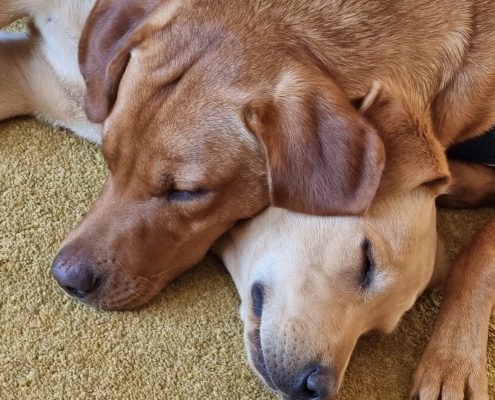All of our puppies are given the best possible start in their first 8 weeks with us. Their development includes
Early socialisation
- General exposure – crates, novel surfaces, uneven surfaces, barriers, problem solving activities, tunnels, props (umbrellas, caps, colourful clothing, musical instruments etc), boot camp rewarding (mazes with hanging items, shallow water, humps), wheelie bins, letter box rattling, door bell sounds, socialisation field trips (garden centres, supermarket car park, school playground, construction sites), appropriate restraint and confinement disciplines
- Car travel – the puppies are taken on regular car trips to get them used to the feel and sensation of movement and traveling
- Noise desensitisation – the puppies are exposed to a variety of sounds from day 1. This is paired with positive stimulus. We use many forms of sounds including a socialisation playlist, general house noise, varied human voices at differing pitches and volumes, loud noises and bangs, construction sounds
- Grooming desensitisation – the puppies are groomed daily from an early age. This includes brushing, nail clipping, bathing and handling
Early Neurological Stimulation
Between 3 and 16 days old the puppies undergo daily ENS. Each of the activities take 5 seconds and there are multiple benefits such as greatly increased tolerance to stressors, exceptional cardio vascular health, enhanced confidence, resilience and coping skills as adult dogs. The activities include:
- Holding puppies vertically-head up tail down
- Holding puppies horizontally-on back
- Holding puppies vertically-head down tail up
- Cotton bud stimulation on their feet and between their toes
- Placing the puppies on a cold object
- Blowing onto the puppies face
- Early Scent Introduction – puppies are exposed to a different scent each day
- Daily weight check
- Daily health check through handling drills (ears, mouth, nose, teeth, paws etc)
Environment
- The whelping box is equipped with surfaces with good grip and traction from birth to help reduce risk of hip dysplasia.
- Sensory and visual stimuli
- A very enriched environment including – tunnels, ramps, steps, toys, items to balance on, ball pools and items to step over
- Confidence building games and activities
- Problem solving activities
- Novel surfaces
- Bumps and textures
- Toilet training
- Crate de-sensitisation
- Social awareness



